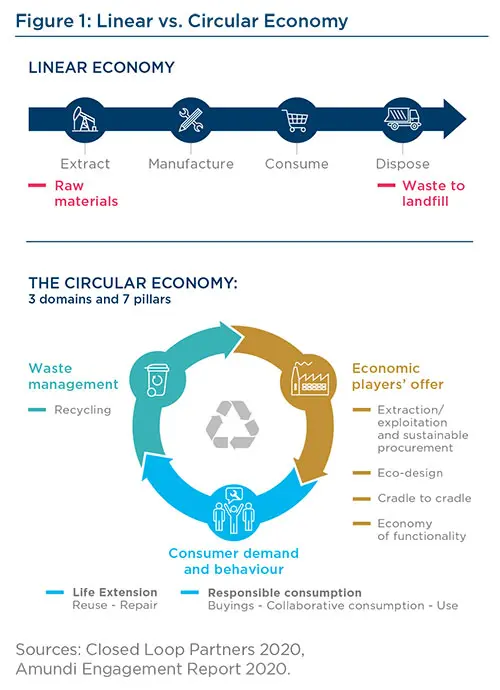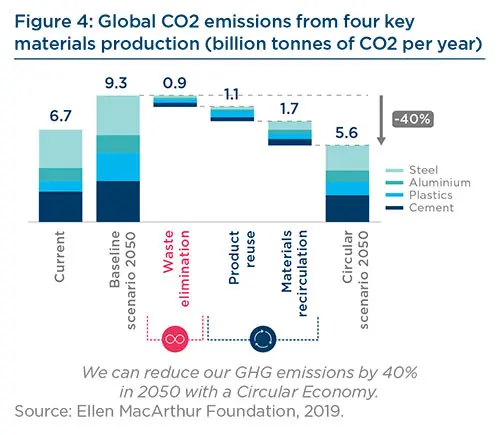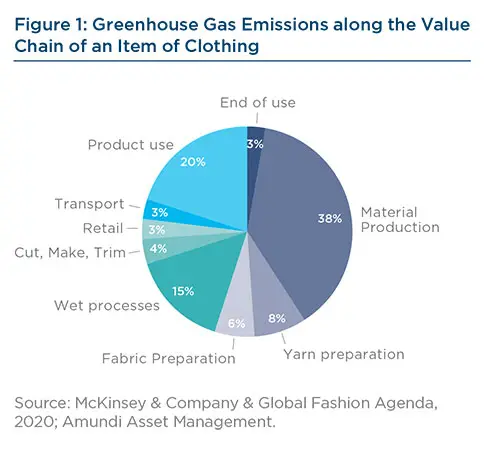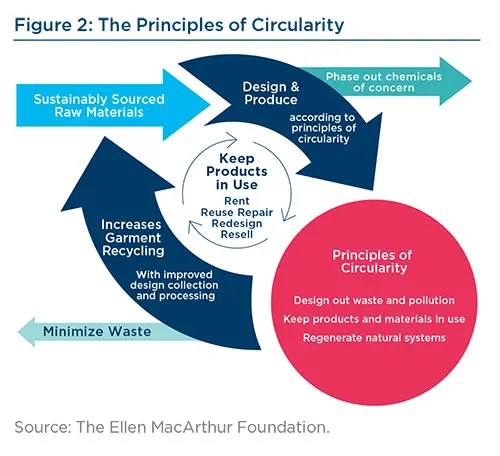Summary
Key Takeways
- Even though there is no singular definition of Circular Economy, it is now clear that it goes beyond recycling and waste management. It represents a systemic shift away from a linear model of production and consumption.
- The main principles behind Circular Economy are better management and use of natural resources, better products design, better-informed consumers and more efficient processing of end-of-life products.
- Circular Economy has become fundamental to limit the environmental impact of manufacturing production and in particular its carbon footprint, thus playing a major role in achieving global climate objectives.
- Circular Economy represents significant opportunities for investors in different sectors, estimated at around $4.5 trillion by 2030 globally.
- Amundi has initiated a three-year engagement campaign with companies across sectors to encourage them to adopt the principles of a Circular Economy all along the value chain.
Sector focus: Fashion
- The fashion industry is estimated to account for around 4-10% of annual global carbon emissions. If it continues on its current path, it could use more than 26% of the total carbon budget associated with a 2°C scenario.
- Although addressing the pollution impacts of the sector all while aligning with emissions targets is a major challenge, it is not impossible.
- The Fashion Industry Charter for Climate Action is helping to guide the fashion industry to Net Zero emissions no later than 2050 to keep global warming below 1.5°C.
- The fashion industry must move towards a circular model to extend the life of clothing and ultimately reduce the emissions intensity of each item.
- A concrete way to encourage companies to adopt better practices is through engagement: Amundi has initiated dialogue with companies in the Apparel & Footwear sector, specifically on designing out waste & pollution measures and keeping products and materials in use.
Introduction
Circular Economy can be defined as an economic system of trade and production which, at all stages of the product lifecycle, aims to increase the efficiency of resource use and reduce environmental impact while developing the well-being of individuals.(1)
Understanding why we must shift from a linear to a circular model is key for our future. Hard law is being introduced in many countries, especially in the European Union and is going to change the way companies can produce and sell their goods over the next decades. Besides, production of goods and land management represent 40% of CO2 emissions. Adopting Circular Economy principles, in particular through products life extension, eliminating waste, reusing products and components, and recirculating materials can contribute to limit global warming to 1.5°C by 2100, in accordance with the Paris Agreement.
This paper presents the main principles behind a Circular Economy, as well as the reasons why it is necessary to shift away from our linear models of production and consumption. As governments are increasingly pushing for regulation in this area, Circular Economy will continue to bring about a wide range of opportunities for investors to finance this economic model centered around the sustainable management and use of resources.
1. Many definitions, one goal
A Circular Economy entails a change in our economic model, allowing to produce sustainable consumer goods, while protecting nature – by giving it time to regenerate – and ensuring the well-being of individuals.
This new economic model translates into:
- A better management and use of natural resources
- Goods designed and produced to last
- Consumers who are informed about the environmental impacts of what they buy and who consume sensibly
- A more efficient system for processing end-of-life products from which more secondary raw materials can be obtained.
Each stage of the production of a product or a consumer good must therefore be reviewed in light of this definition.
Still, the concept of Circular Economy is constantly evolving and there is no universal definition.
Each of these organizations propose different visions of the Circular Economy and put forward distinct characteristics of it. However, they agree on the bottom line: the need to limit the impact of human activities on nature.
| The definition we have chosen at Amundi is based on studies by ADEME, the Ellen MacArthur Foundation and the European Commission: |
|
1. ADEME «According to ADEME, the Circular Economy can be defined as an economic system of exchange and production which, at all stages of the life cycle of products (goods and services), aims to increase the efficiency of the use of resources and reduce the impact on the environment while developing the wellbeing of individuals.” ADEME has a systemic vision of the Circular Economy. It is above all a matter of inventing a new economic model whose primary objective is to reduce the environmental impact of the goods and products that human societies use while allowing them to increase their wellbeing. 2. ELLEN MACARTHUR FOUNDATION “The Circular Economy gives us the tools to tackle climate change and biodiversity loss together, while addressing important social needs. It gives us the power to grow prosperity, jobs, and resilience while cutting greenhouse gas emissions, waste, and pollution.” The Ellen MacArthur Foundation has a vision centered on the protection of nature and focuses on the fact that the Circular Economy must be restorative and regenerative by design, by limiting the production of waste and/or recycling it to make new products. 3. EUROPEAN COMMISSION “A Circular Economy aims to maintain the value of products, materials and resources for as long as possible by returning them into the product cycle at the end of their use, while minimizing the generation of waste.” The European Commission has an economic vision and is interested in maintaining the market value of products throughout their life, especially through the market value of recycled materials that are integrated into new products. |
The rationale behind a Circular Economy is that we live in a world with finite materials and natural resources. We cannot keep wasting them as we do with the linear model: either we will face shortages in natural resources and/or we will put too much pressure on the environment, destroying it while we are fully dependent on it.

Legislation has started to flourish, especially in Europe, to push for a Circular Economy. The European Union is committed to being a carbon neutral continent by 2050 and to decoupling economic growth from resource use. This commitment stems from a simple fact: climate change and environmental degradation are existential threats to Europe and the world. The EU seeks to accelerate the transition towards a regenerative growth model and to maintain its resource consumption within planetary boundaries. Its objective is to double its circular material use rate by 2030.
One of the key elements of the EU’s economic transformation is based on mobilizing the industry for a clean and Circular Economy, through the New Circular Economy Action Plan adopted in March 2020. This new strategy marks a turning point in the definition of Circular Economy. Indeed, it is no longer only about waste treatment or recycling but is defined as a whole new model in which every step of the production process needs to be rethought. Recycling is only one pillar of a Circular Economy, alongside eco-design, life extension, or economy of functionality.
This shift in definition is illustrated by the fact that, in February, the European Parliament voted in favor of establishing a “right to repair” – which means that all new washing machines, hairdryers, refrigerators and displays sold in EU countries must be repairable for up to 10 years. Similar requirements were made back in November 2019 for smartphones, laptops and other consumer electronics.
Consequently, the goal is clear: sustainability is the key word and all means can be used, beyond recycling and waste treatment.
2. Why now?
The linear economic model we know today consists of extraction, production, consumption and disposal. Since the 19th century, economic growth has been based on an escalating extraction of natural resources, a growing production of standardized goods, an ever-increasing consumption and renewal of these goods, and their disposal at the end of the race.
The extraction of natural resources includes both non-renewable resources, such as mineral raw materials and fossil fuels, as well as renewable resources such as air, water, soil or fauna and flora.
The demographic and economic explosion of the 20th century and the advent of mass consumption with cheap and easily replaceable products have put too much pressure on our environment and are now sounding the death knell of this linear economy. Indeed, this linear economy has overlooked two important points: our natural reserves are limited and nature needs time to regenerate and make new resources available.
According to the Organization for Economic Co-operation and Development (OECD), the world population is expected to reach 9 billion people by 2050 and the global economy is expected to quadruple, resulting in an increasing demand for energy and natural resources.
While we consumed 7 gigatonnes (Gt) of raw materials worldwide in 1900, this number increased to 50 Gt in 2000 and to 85 Gt in 2020 (Krausmann, 2009). Moreover, projections suggest 183 Gt in 2050 (UNEP, 2016).

At this pace of extraction, some raw materials such as nickel, copper, manganese, or cobalt will no longer be available in the next 50 years, according to scientific experts.
The same is true for renewable natural resources. The depletion of natural resources is pointed out every year by an NGO, The Global Footprint Network, which calculates the Earth Overshoot Day. This marks the day when humanity’s demand for ecological resources and services in a given year exceeds what Earth can regenerate in that year. The world has been in an ecological deficit since 1970. In 2019, Earth Overshoot Day (2) was on July 29th, which means that 1.7 Earth planets were needed to support humanity’s annual demand on the ecosystem, versus only one planet in 1970. Since 2001, this date is on average 3 days earlier per year (3). Should the global population reach 9.6 billion by 2050, the equivalent of almost three planets could be required to provide the natural resources needed to sustain current lifestyles.

Therefore, the linear model of producing more and more and throwing away large amounts of waste, without any recycling, is in contradiction with planetary limits.
In fact, the consumer society has given rise to a society of waste. Global waste production was estimated to be 1.3 billion tonnes per year in 2012 vs 2.01 in 2018 (+55%). It is expected to grow to 3.4 billion tonnes by 2050 under a business-as-usual scenario (+160%) (4). This high increase will come mainly from developing countries in Asia and Africa. Amongst these wastes, some are recyclables, such as paper, cardboard, plastic, metal and glass: they represent from 16% of waste streams in low-income countries to 50% in high-income countries. Despite this high recyclable rate, only one-third of waste in the high-income countries is recovered through recycling and composting.
In addition, manufacturers make very little use of recycled materials in their products: on average only 12% of material resources used in the EU in 2016 came from recycled products and recovered materials – thus saving extraction of primary raw materials.
Facing these disappointing figures, it is urgent to review the way we produce in order to ensure better product recyclability, right from the design stage, but also better sorting and a better recycling rate. This will allow the development of a real market for secondary raw materials, thus limiting the environmental impact of manufacturing production, and in particular its carbon footprint.
Indeed, the manufacturing and transport of products contribute strongly to global warming, even though the carbon budget we have at our disposal is limited if we want to limit global warming to 1.5°C in 2100, in accordance with the Paris Agreement. Respecting this carbon budget implies a reduction of global CO2 emissions, either through products that consume less energy and natural resources or through a decrease in our production and consumption of goods.
3. Circular Economy: a tool to fight against climate change
In light of this, the Circular Economy can be a great tool to limit global warming.
Between 1950 and 2020, CO2 emissions in the atmosphere have increased from 6 billion tons to 36 billion tons, i.e. x6 in 60 years (and x18 compared to 1900). This increase in CO2 emissions into the atmosphere is directly linked to human activities and in particular to industrial and manufacturing production, the third most emitting sector according to the International Energy Agency (IEA).
The industrial and consumption choices we have made and continue to make, and the linearity of our economy based on the principle “extract, produce, consume, throw away” explain this increase in CO2 emissions.
In order to limit global warming to 1.5°C, the International Panel on Climate Change (IPCC) has defined the carbon budget that we can still spend in its latest report: “As of January 1, 2018, we had 420 Gt of CO2 remaining in our «carbon budget» if we want to have a 67% chance of remaining under the 1.5° temperature increase by 2100”.(5) We currently emit about 40 Gt of CO2 every year, which means that our CO2 budget associated with 1.5 °C of warming will be exhausted by 2030’s if emissions remain on the level of the late 2010s.
Moreover, beyond 2°C, scientists estimate that the consequences for the planet’s habitability will be major (6).
To drastically cut our current CO2 emission levels, we need to imagine a new economic model in which producing and consuming is less emissive. The Circular Economy, by making possible to limit the extraction of natural resources, by limiting production thanks to the extension of the lifespan of products and by allowing better recycling of materials, can play a major role in achieving global climate objectives.
Decarbonizing the energy sector is necessary to meet Paris Agreement targets. However, it will be insufficient as 45% of CO2 emissions are directly linked to the production of goods and the management of land. Consequently, a thorough transformation is needed in the way we produce and use goods.
A 2019 study by the Ellen MacArthur Foundation demonstrates that applying Circular Economy strategies in just five key areas – cement, aluminum, steel, plastics, and food – can eliminate more than 40% of the remaining emissions from the production of goods. This corresponds to 3.7 billion tonnes of CO2 equivalent in 2050 and would be comparable to cutting current emissions from all transport to zero (7).
Three main factors can help reduce CO2 emissions due to good manufacturing for the four key materials production, which are cement, aluminum, steel and plastics:
- Waste elimination can help reduce 0.9bn tonnes of CO2 per year (-9.6%): this is possible through material efficient designs for buildings, industrialized construction processes and light weighting designs for vehicles. This allows to reduce the amount of material input in products and assets, and reduce waste generation during construction.
- Product reuse can help reduce 1.1bn tonnes of CO2 per year (-12%): new business models such as renting, sharing and payper-use can increase the use of products and extend the products’ longevity through reuse, refurbishment and remanufacturing. That way, the need for new products and end-of-life treatments decrease. The need for virgin materials, such as steel, plastics, cement and aluminum decrease as well, and so do the CO2 emissions.
- Materials recirculation can help reduce 1.7bn tonnes of CO2 per year (-18%): new business models that consist in collecting, sorting and recycling activities help reduce emissions. The increase of recycling rates allow to decrease the demand in virgin materials, which helps reducing emissions from production and end-of-life incineration by using less energy-intensive facilities compared to the production of virgin materials.

Our planet boundaries and climate change force us to review our economic linear model and to replace it by a circular model that will allow to extract less materials from the Earth, to better use the products we have at our disposal and to better recycle them. As identified by the EU Green Deal and the New Circular Economy Action Plan, our industry must change.
4. What implications for investors?
The transition to a Circular Economy brings about significant long-term opportunities for investors, estimated at around $4.5 trillion by 2030 globally. (8)
While still very much in early stages of development, the market for financing the Circular Economy has taken off in the last years, demonstrating how investors are capturing new opportunities across asset classes and sectors. There are several ways for investors to get involved. First, investors can turn to private markets to finance Circular Economy companies. They can also choose to actively invest on public markets by favoring corporates that have good Circular Economy performances. Some investors have also turned to passive investing, reproducing the performance of indices focused on Circular Economy leaders. Furthermore, engagement can be an effective way to encourage companies to improve their practices by adopting Circular Economy principles. Amundi is currently focusing on engagement with companies from different sectors to influence their business models and spread best practices across the economy.
Investment opportunities
When it comes to Circular Economy, investment opportunities can be diverse and offer attractive returns. These include opportunities in different sectors: buildings, mobility, food, fashion, packaging, etc. On top of offering Circular Economy growth potential, these opportunities can help meet broader governmental objectives, such as the Sustainable Development Goals (SDGs). For example, Goal 12 “Responsible Consumption and Production” can be particularly relevant for investors seeking to align with global sustainable objectives. It highlights the importance of decoupling economic growth from environmental degradation, and essentially of “doing more with less”. (9) On top of the SDGs, comprehensive Circular Economy frameworks exist, such as the one developed by the Ellen MacArthur Foundation for example.
Moreover, private funds are being supplemented by public sources of financing. In 2019, the European Investment Bank (EIB) launched a Joint Initiative on the Circular Economy with the EU’s largest National Promotional Banks and Institutions. This initiative aims to provide €10 billion in investments available until 2023, under the form of loans, equity investment, or guarantees to eligible projects.
Governments and financial regulators have their role to play in scaling up investments in this area. Indeed, investors need standardized definitions and metrics for Circular Economy investments. In that regard, the EU Taxonomy provides guidance by incorporating the Circular Economy as one of the key elements to classify sustainable and climate neutral economic activities.
Risk management
Central banks and financial regulators could also benefit from expanding their risk assessments and financial modelling beyond climate change issues, by analyzing the potential of the Circular Economy to address these risks. In fact, Circular Economy opportunities can lead to the development of scenario analyses on solutions that could complement the current focus on supply-side measures with demand-side changes (e.g. car electrification vs. car-sharing solutions).
Engagement
Finally, engagement can be a useful tool to understand company implementation of Circular Economy in practice and the main issues associated to it. It can also allow investors to identify viable solutions promoting a Circular Economy that have been tested by companies, as well as best practices in each sector. Over the medium to long term, companies will be encouraged to go beyond marginal adjustments in their business models to implement more radical change. Ultimately, investors have the ability to influence companies to adopt the principles of a Circular Economy across the value chain, from eco-design to the end-of-life.
Amundi has been particularly active on the engagement front to promote the adoption of Circular Economy principles. In 2020, we started a three-year engagement campaign with companies across the Electronics & ICT, Batteries & Vehicles, Textiles, and Construction & Building sectors. In total, 27 companies have accepted to answer our questions on this subject, based all over the world, from North America to Europe and Asia. Amundi has developed a proprietary evaluation tool assessing companies through four criteria:
- How key is the circular economy in the governance bodies and in the company’s strategy?
- How ambitious are the company’s commitments on the circular economy?
- How is the circular economy implemented in the day to-day business?
- How is the company trying to make its products last longer?
Overall, engagement results have shown that, despite varying levels of maturity, three sectors are clearly ahead: Electronics & ICT, Textiles and Automobiles. By contrast, for Construction & Building Products, we see that circular economy is only at a nascent stage. Going forward, Amundi will focus its engagement on areas of priority that will vary between the type of company and level of maturity within each sector to ensure our engagements have the highest impact. Fortunately, upcoming legislation, especially at the European level, will also incentivize companies to turn away from decades of easy-to-replace products, and take into account environmental considerations such as product longevity and recyclability.
To conclude, Circular Economy aims to address the negative environmental impacts brought about by the “take-make-dispose” principle of the linear economy. More importantly, it represents a systemic shift in the way we produce and consume, allowing to build long-term resilience and providing environmental and societal benefits. Investors should consider opportunities in this field as they can help address their short and long term goals, while allowing them to participate in the optimization of resource use and circulation.
_______________________________
Sources :
1. ADEME, https://www.ademe.fr/expertises/economie-circulaire.
2. The date when humanity’s demand for ecological resources and services exceeds what Earth can regenerate in that year in a given year.
3. If we exclude 2020 for which the Earth Overshoot Day was on August, 29th due to Covid-19.
4. https://openknowledge.worldbank.org/handle/10986/30317
5. https://www.ipcc.ch/site/assets/uploads/sites/2/2019/06/SR15_Full_Report_Low_Res.pdf
6. Rapport GIEC 2018
7. https://circulareconomy.europa.eu/platform/sites/default/files/emf_completing_the_picture.pdf
8. https://www.closedlooppartners.com/wp-content/uploads/2021/02/Closed-Loop-Partners-2020-Impact-Report-3.pdf
9. UN SDG 12 Responsible Consumption and Production https://www.un.org/sustainabledevelopment/sustainableconsumption-production/.
Net Zero and Circular Economy in the Fashion Sector
The True Cost of Fashion
The fashion industry is estimated to account for around 4-10% of annual global carbon emissions.(1, 2) In 2015, GHG emissions from textile production totaled 1.2 billion tons of CO2e (3) which is more than international flights and maritime shipping combined.(4) One ton of textiles generates roughly 17 tons of CO2 equivalent, compared to 3.5 tons for plastic and less than 1 ton for paper. (5) If the sector continues on its current path, it could use more than 26% of the total carbon budget associated with a 2-degree pathway (6).
There are emissions implications at all parts of the clothing value chain. First, polyester clothing is a kind of plastic, meaning it is derived from oil. The textile industry uses 98 million tons of oil per year, which is expected to increase to 300 million by 2050 at the current rate (7), increasing global CO2 emissions significantly. Second, for production, while coal-powered electricity has declined in Western countries, it is on the rise in many countries where apparel and footwear are manufactured such as Vietnam, India, Bangladesh, and China (8). Finally, regarding end of life, a garbage truck sizedload of clothes is either burnt or buried in landfill every second. (9) While synthetic fibers can take at least 200 years to decompose, 100% natural fibers such as cotton and wool generate methane when landfilled, which has a global warming effect 84x higher than CO2 in the short term. Tackling methane emissions such as the ones generated by the textile industry will thus play a key role in addressing climate change. The Global Methane Pledge that will be launched at COP26 aims to take a first step in this direction. (10)

Reaching Net Zero
The Fashion Industry Charter for Climate Action is helping to guide the fashion industry to Net Zero emissions no later than 2050 to keep global warming below 1.5°C. This Charter includes a target of 30% greenhouse gas emissions reductions by 2030 and a commitment to analyze and set a decarbonization pathway for the industry based on science-based targets (SBTs). (11)
Some of the key overarching focus areas to ensure alignment with a Net Zero trajectory include raw materials, manufacturing & energy, logistics, as well as brand & retailer owned and operated emissions, among others.
All about Scope 3
The greenhouse gas emissions within the value chain – referred to as Scope 3 emissions – are significant for this sector. These include both downstream and upstream emissions, and are also the most complicated to measure.
According to the Science Based Targets Initiative (SBTi), if a company’s relevant Scope 3 emissions represent 40% or more of the total Scope 1, 2, and 3 emissions, a specific Scope 3 target is required. For a Scope 3 target, companies must set one or more emissions targets for suppliers or targets around customer engagement. Moreover, these should cover at least two-thirds of the total Scope 3 emissions, in conformance with the GHG Protocol Corporate Value Chain (Scope 3) Accounting and Reporting Standard.
Climate Benefits of a Circular Economy
Circular Economy is a key catch phrase in the fashion sector, which has been promoted as a way to help solve the fashion industry’s waste problem that results from the impacts of a linear model. However, a circular economy for textiles could also significantly reduce carbon emissions and help the sector better align with a 1.5°C pathway. For example, if the use of garments doubled on average, greenhouse gas emissions would be about 44% lower.
Furthermore, if textiles were made from recycled materials they would have lower emissions than items made from virgin materials. For example, estimates suggest that substituting polyester with its recyclable counterpart, rPET, would reduce CO2 equivalent emissions by up to 40%.(12) This combined with the use of low-carbon materials and production processes – including an increased use of renewable energy – would further help reduce greenhouse gas emissions linked to Scope 3 and better align the industry with Net Zero ambitions. McKinsey estimates this emissions reduction at around 1.1 billion metric tons of CO2 equivalent by 2030.(13)
What is a Circular Model? Rethinking the lifecycle of clothes from design to waste treatment
To reap these benefits, the fashion industry must move towards a circular model to extend the life of clothing and ultimately reduce the emissions intensity of each item. This includes promoting garment rental, resale, repair, in addition to increasing clothing collection and recycling to make new items out of old clothing instead of having it sent to landfill.

Reducing Scope 3 Emissions is an Essential Part of a Circular Model
It is important to note that a key part of circularity according to the Ellen MacArthur Foundation also involves regenerating natural systems. The Foundation outlines this as both embracing regenerative agriculture when recycled materials are not possible, as well as ensuring that production processes reduce energy water and waste (also known as addressing Scope 3 impacts). Thus, emissions targets for suppliers are both essential for Net Zero and in achieving a Circular Economy.
Circularity Models have their Own Climate Considerations
Many companies in the fashion sector are quickly embracing circular economy opportunities, in addition to climate commitments. For example, some companies are setting targets to increase the recycled content of their products or partnering with startups in the rental and resale markets to help extend the life of their products.
It is important to note that, while circularity can play a key role in achieving Net Zero goals by helping to reduce emissions resulting from material production, circular economy opportunities can have their own climate considerations.
For example, in a recent study published in 2021 in Environmental Research Letters, greenhouse gas emissions were calculated based on five different models for owning and disposing clothing, including a baseline linear mode, extended use, resale, recycling, and renting. According to this study, renting clothing had the highest climate impact of all, even higher than disposing clothing in landfill. Recycling also had a high carbon impact due to the emissions generated in the recycling process.
Moreover, the study was based on using current modes of transport. However, if companies were to use zero- or low-emissions transport models such as bike couriers and parcel lockers, reselling would be more competitive from a climate perspective.
Life Cycle Assessments Can Provide Guidance on Circularity and Net Zero
Thus, the important takeaway is that any new business model will bring about both opportunities and costs. To tackle these issues, companies must take into account life cycle assessments into their new circular strategies and business models to make informed decisions and ensure alignment with Net Zero objectives.
Circularity and Net Zero Need to Go Hand in Hand but it will not be Easy
There is no doubt the fashion industry has a major environmental impact and needs to go through significant changes in the years to come. This implies having to make tough decisions to find circular business models that reduce its environmental impact and are compliant with Net Zero pathways. While it is a major challenge to address the pollution impacts of the sector all while aligning with emissions targets, it is not impossible. It will rely on robust life cycle assessments, enabling decision-makers at all levels of the company to make informed decisions to find those winwin Circular and Net Zero opportunities.
An efficient and concrete way to encourage companies to adopt better practices is through engagement. Launched in 2020, circular economy is a major topic of thematic engagement at Amundi and covers many industries. When it comes to the Apparel & Footwear sector, engagement has focused on dialogue with seven European companies. Amundi’s engagement has so far focused on two key elements: designing out waste & pollution and keeping products and materials in use.
As circularity must go hand in hand with Science Based Climate commitments, Amundi also conducts engagement with companies in various sectors to invite them to commit, set, or upgrade their climate targets to align with the SBTi.
To conclude, a wide array of climate and circular economy opportunities are still left untapped by the fashion industry. Moreover, these could be entirely compatible with the sector’s economic growth: if the industry were to address the negative impacts of its activities, the overall benefit to the world economy has been estimated to be about €160 billion by 2030. However, reaching this implies more than simply adjusting activities to reduce fashion’s negative environmental footprint. More than ever, the sector needs to engage in a systemic shift to build longterm resilience and align with net zero objectives as set by the Paris Agreement.
_______________________________
Sources:
1. https://www.worldbank.org/en/news/feature/2019/09/23/costo-moda-medio-ambiente.
2. https://www.mckinsey.com/~/media/McKinsey/Industries/Retail/Our%20Insights/Fashion%20on%20climate/Fashion-onclimate-Full-report.pdf.
3. Ellen MacArthur, A New Textiles Economy, 2017.
4. International Energy Agency, Energy, Climate Change & Environment: 2016 insights (2016), p.113.
5. Eunomia, The potential contribution of waste management to a low carbon economy (2015).
6. Compared to the IEA 2°C pathway 2050 which allows for 15.3 giga tons of CO2 equivalent.
7. Ellen MacArthur, A New Textile Economy, 2017.
8. https://sciencebasedtargets.org/resources/legacy/2019/06/SBT_App_Guide_final_0718.pdf.
9. Ellen MacArthur, A New Textile Economy, 2017.
10. https://ec.europa.eu/commission/presscorner/detail/en/IP_21_4785.
11. Science based Targets initiative.
12. TextileExchange, 2018.
13. https://www.mckinsey.com/industries/retail/our-insights/fashion-on-climate.





